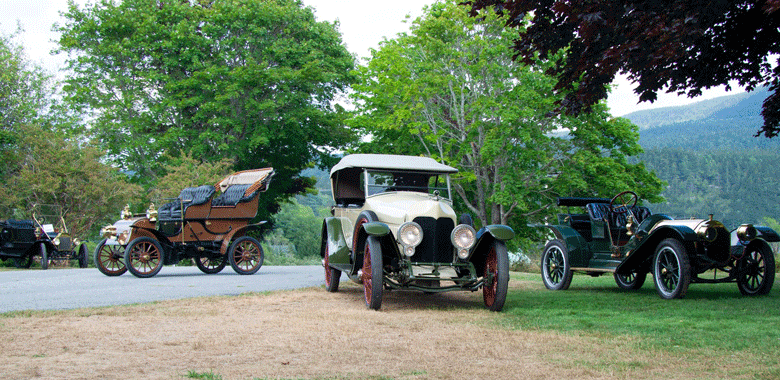“It’s nothing but a big picnic ground for ‘Elks,’ and ‘Spiritualists,’ and ‘Holy Ghosters.’ The whole island is full of campers from Skowhegan, Bucksport, Rockland, and Ellsworth, that don’t do nothin’ but sit in front of their tents, eat bananas and read the Sunday papers.”
—Arthur Train
Mount Desert Island and Acadia National Park have always had a tumultuous relationship with cars.
Despite society’s embrace of automobiles in the early years of the last century, skepticism on the island was high, particularly among the wealthy elites who built lavish summer “cottages” in which to escape the sweltering heat and foul effluvia of East Coast cities.
Even with laws banning cars from driving onto the island, enterprising local residents began bringing vehicles in by barge. The summer community responded by getting the Maine Legislature to pass a law banning the transfer of cars across local wharfs and piers. So people built their own, often using boat parts.
The “Auto War” between residents and summer swells reached a fever pitch in 1913 when the legislature finally rescinded local bans and the rest, as they say, is history.
Rockefeller … was instrumental in creating and funding construction of the spectacular Park Loop Road…
During the debate, New York newspaperman and summer resident Arthur Train, writing in the Bar Harbor Record, lamented the coming age of the “automobilists,” predicting it would spell doom in just a few years.
By 1920, Train wrote, Bass Harbor would become the island’s commercial center. He predicted, “The erstwhile little fishing village is now a thriving town with two large hotels owned by Moe Levy of New York, one of them having a thousand fully furnished rooms, 14 garages, two gasoline factories, car works, and train sheds.”
Somesville, which counts itself among those claiming to have the prettiest village in Maine, did not escape unscathed in his dystopian vision. “This place is a regular Coney Island—all except the camels,” Train predicted. “It’s nothing but a big picnic ground for ‘Elks,’ and ‘Spiritualists,’ and ‘Holy Ghosters.’ The whole island is full of campers from Skowhegan, Bucksport, Rockland, and Ellsworth, that don’t do nothin’ but sit in front of their tents, eat bananas, and read the Sunday papers.”
Looking to escape that scrum was Acadia’s biggest benefactor, John D. Rockefeller Jr. His desire to ride his horse-drawn carriages unmolested by cars, led to the creation of Acadia’s carriage road system which remains free of cars to this day. Ironically it was the swelling profits from motorcar gasoline sales by his family’s company, Standard Oil, that made that possible.
Rockefeller, too, understood people’s affection for the automobile as a method of access. So he was instrumental in creating and funding construction of the spectacular Park Loop Road that is the main motor route to much of the park. There is no way he, park co-founders George Dorr or Charles Eliot, all contemporaries of Train, could have predicted what challenges their gift would face more than a century later.
Fast forward to today and too many cars is one of the park’s biggest problems negatively impacting natural resources and visitor experiences. That has spurred the adoption of a formal transportation plan that calls for greater use of the fare-free Island Explorer shuttle buses (which have been supplanting tens of thousands of cars annually for more than 20 years), a shift to smaller tour buses, and requiring reservations for the most over-loved places.
Since 2021 reservations are required to access the popular summit between late-May and late-October.
A crush of 450 cars in lots designed for just 150 at sunrise and sunset precipitated more than 70 closures of the Cadillac Mountain Road in 2020. Since 2021 reservations are required to access the popular summit between late-May and late-October. A timed reservation system for Ocean Drive has been put on hold while technology and management issues are worked out.
Next up is the Jordan Pond House area where the propensity of folks to simply career off road and up and over roadside vegetation in pursuit of a place to park has prompted shoulders there to be barricaded with rocks, signs, cones and metal stakes.
In the decades since the Auto Wars, the island’s relationship with cars has become more of a counterinsurgency operation. The alignment of the factions has reversed—residents complaining about too many cars and traffic and today’s summer vacationers unable to image visiting here without a vehicle, preferably a giant SUV with two kayaks, four ebikes, and a tailgate platform holding an expensive Himalayan cooler that requires four people to move.
Errant and self-entitled drivers have morphed from being merely irksome to become a form of entertainment. A Facebook page, “Welcome to Bar Harbor’s Famous Parking Show,” shares photos of people parked in crosswalks, taking up multiple spaces or blocking traffic after turning on their four-way flashers, better known locally as “park anywhere lights.”
The Bar Island sandbar got national network and newspaper exposure this spring when the owner of an expensive Ford Bronco attempted to do doughnuts on some mudflats and became hopelessly mired. It took days to get it out. A month earlier another group of joyriders learned a rental car isn’t much of a submarine thanks to the incoming tide on Seal Harbor Beach. So far this season it’s high tide 4, visitors 0.
It is almost like the ocean has developed its own immune system, taking up arms against a noxious infection, isolating and destroying the invaders.
Acadia, of course, is not alone it its transportation troubles. Many national parks are experiencing the same woes and are taking the same steps. It remains to be seen if the implementation of the transportation plan’s recommendations, including the creation of a new gateway visitor center and bus hub where people can leave their cars in Trenton, will be enough in the long run.
Doing nothing, of course, will just serve to validate Arthur Train’s prescience, however fanciful or exaggerated his predictions may have been.
One of the characters in Train’s essay laments what was lost on the island due to cars.
“When they first let in the wiz chariots, folks thought that it would whoop up business to beat the band. The hotels all built additions and every stable was turned into a garage. The storekeepers laid in new stock and every restaurant in town hired a corps of extra waiters. Then everyone got ready for the boom to come.”
In Train’s future, however, the flood of cars destroyed the very character people came to see.
With more than four million visits in 2021, Mount Desert Island has certainly seen boom times. With Acadia’s relationship with cars at a crossroads, action taken over the next few years will determine whether or not Train’s predicted “wiz chariot” nightmare actually comes to pass.
Hailing from a family whose roots include Maine author Ruth Moore and lighthouse heroine Abbie Burgess, Earl Brechlin covered Mount Desert Island as a journalist for more than 40 years. A registered Maine Guide and award-winning Maine author, he resides in Bar Harbor where he is president of the Bar Harbor Historical Society.





